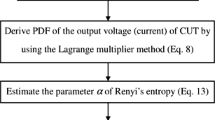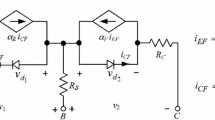Abstract
This paper proposes a new single or multiple soft analog circuit fault diagnosis approach based on the minimum fault number rule. It is based on the consideration that the fact that the probability of a single soft fault is much greater than that of a multiple fault if the related fault modes are independent. In this way, a new diagnostic strategy based on the circuit sensitivity analysis is proposed. The proposed strategy is an optimization-based one, whose objective is to find the minimum value of unaccepted parameter deviations which satisfy all those constraints, and the constraints equations are actually the voltage increment equations in all test nodes and the changing range of each element. The diagnosis process can fulfill the requirement of fault detection and fault isolation. It enables a fast or a real-time diagnosis in practical engineering. A DC circuit example and an AC circuit example are presented to demonstrate the effectiveness of the proposed approach.


Similar content being viewed by others
References
Bandler, J. W., & Salama, A. E. (1985). Fault diagnosis of analog circuits. Proceedings of the IEEE, 73(8), 1279–1325.
Wey, C. L., WU, C., & Saeks, R. (1988). Analog Fault diagnosis. In F. Lombardi & M. Sami (Eds.), Testing and diagnosis of VLSI and ULSI (Vol. 151). Dordrecht: Springer.
Devarayanadurg, G. & Soma, M. (1994). Analytical fault modeling and static test generation for analog ICs. In Proceedings of the 1994 IEEE/ACM international conference on computer-aided design (pp. 44–47).
Catelani, M., Ada, F., & Cesare, A. (2002). A fuzzy approach for soft fault detection in analog circuits. Measurement, 32, 73–83.
Huang, K., Stratigopoulos, H., & Mir, S. (2010). Fault diagnosis of analog circuits based on machine learning. In: Design, automation & test in Europe conference & exhibition (DATE) (pp. 1761–766). IEEE
Worsman, M. & Wong, M. (1998). Nonlinear circuit fault diagnosis with large change sensitivity. In 1998 IEEE international conference on electronics, circuits and systems (Vol. 2, pp. 225–228).
Deng, Y., Shi, Y., & Zhang, W. (2012). Diagnosis of incipient faults in nonlinear analog circuits. Metrology and Measurement Systems, 19(2), 203–218.
Mehran, A., & Farzan, A. (2007). A modular fault-diagnostic system for analog electronic circuits using neural networks with wavelet transform as a preprocessor. IEEE Transactions on Instrumentation and Measurement, 56(5), 1546–1554.
El-Gamal, M. A., & Mohamed, M. D. A. (2007). Ensembles of neural networks for fault diagnosis in analog circuits. Journal of Electronic Testing, 23, 323–339.
Cui, J., & Wang, Y. (2011). A novel approach of analog circuit fault diagnosis using support vector machines classifier. Measurement, 44(1), 281–289.
Long, B., Tian, S., & Wang, H. (2012). Diagnostics of filtered analog circuits with tolerance based on LS-SVM using frequency features. Journal of Electronic Testing, 28, 291–300.
Xie, T., & He, Y. (2014). Fault diagnosis of analog circuit based on high-order cumulants and information fusion. Journal of Electronic Testing, 30, 505–514.
Bharat, R., Prasannamoorthy, V., & Devarajan N. (2009). Fuzzy based time domain analysis approach for fault diagnosis of analog electronic circuits. In Proceedings of the international conference on control, automation, communication and energy conservation (pp. 1–6).
Bo, F., Peng, X., Junjie, L., & Dong, M. (2009). The analog circuit fault diagnosis based on neural network and fuzzy logic. In: Proceedings of control and decision conference (CCDC’09), 2009 (pp. 199–202).
Sheppard, J. W., & Butcher, S. G. W. (2007). A formal analysis of fault diagnosis with D-matrices. Journal of Electronic Testing, 23, 309–322.
Ahrikencheikh, C. & Spears, M. (1999). Limited access testing of analog circuits: handling tolerances. In Proc. int. test conference (pp. 577–586).
Devarayanadurg, G. & Soma, M. (1994). Analytical fault modeling and static test generation for analog ICs. In IEEE int. conf. on computer-aided design, San Jose, CA, 1994 (pp. 44−47).
Devarayanadurg, G. & Soma, M. (1995) Dynamic test signal design for analog ICs. In IEEE int. conf. on computer aided design, San Jose, CA, 1995 (pp. 627−630)
Tadeusiewicz, M., Halgas, S., & Korzybski, M. (2002). An algorithm for soft-fault diagnosis of linear and nonlinear circuits. IEEE Transactions on Circuits and Systems I, 49(11), 1648–1653.
Tadeusiewicz, M., Sidyk, P., & Halgas, S. (2007). A method for multiple fault diagnosis in dynamic analogue circuits. In 18th European conference on circuit theory and design, 2007, ECCTD 2007 (pp. 834–837).
Gao, Y., Yang, C. L., & Tian, S. L. (2014). Methods of handling the aliasing and tolerance problem for a new unified fault modeling technique in analog-circuit fault diagnosis. Advanced Materials Research, 981, 11–16.
Zhou, L., Hu, Y., Zhang, C., Li, Z., Hao, D., & Shi, Y. (2013) The application of multi-objective programming in single soft-fault diagnosis of nonlinear analog circuit with tolerance. In 2013 IEEE 11th international conference on electronic measurement & instruments (ICEMI) (Vol. 2, pp. 829–832).
van Dort, M. & Klaassen, D. (1995). Circuit sensitivity analysis in terms of process parameters. In 1995 International electron devices meeting (IEDM ‘95) (pp. 941–944).
Worsman, M. & Wong, M. (1998). Nonlinear circuit fault diagnosis with large change sensitivity. In 1998 IEEE int conf on electronics, circuits and systems (Vol. 2, pp. 225–228).
Peng, W., & Shiyuan, Y. (2005). A new diagnosis approach for handling tolerance in analog and mixed-signal circuits by using fuzzy math. IEEE Transaction Circuits Systems I, 52(10), 2118–2127.
Yu, W., & He, Y. (2015). Analog circuit fault diagnosis via sensitivity computation. Journal of Electronic Testing, 31, 119–122.
Zhang, W., Zhou, L., Shi, Y., Huang, C., & Li, Y. (2010). Soft-fault diagnosis of analog circuit with tolerance using FNLP. Metrology and Measurement Systems, XVII(3), 349–362.
Jantos, P., Grzechca, D., & Rutkowski, J. (2009). Global parametric faults identification in analogue electronic circuits. Metrology and Measurement Systems, XVI(3), 391–402.
Ahmed, R. F., Radwan, A. G., Madian, A. H., & Soliman, A. M. (2011). Analog fault diagnosis by inverse problem technique. In 2011 IEEE int. conf. on microelectronics (ICM), Hammamet (pp. 1–5).
Author information
Authors and Affiliations
Corresponding author
Rights and permissions
About this article
Cite this article
Ji, L., Hu, X. Analog circuit soft-fault diagnosis based on sensitivity analysis with minimum fault number rule. Analog Integr Circ Sig Process 95, 163–171 (2018). https://doi.org/10.1007/s10470-018-1111-y
Received:
Revised:
Accepted:
Published:
Issue Date:
DOI: https://doi.org/10.1007/s10470-018-1111-y




